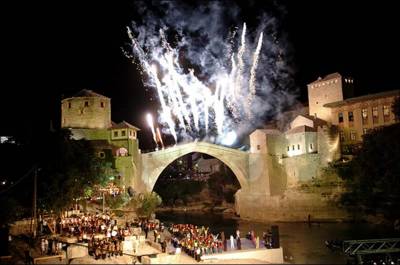
Tom Dubravec/European Pressphoto Agency

By RICHARD BERNSTEIN
Published: July 24, 2004:
MOSTAR, Bosnia and Herzegovina, July 23 - With music, dance, colored lights and speeches about reconciliation and a better future, this afflicted Balkan town formally reopened on Friday the famous and historic bridge that was obliterated a decade ago during the fighting in the former Yugoslavia.Here are some views of the old bridge:
It was not really the old bridge of Mostar that was reopened. The original bridge was built in 1566 under the Ottoman Turks and celebrated during the 427 years of its existence for the grace of its arched 95-foot span. What has been completed is a painstakingly faithful, stone-by-stone replica of that bridge, destroyed on Nov. 9, 1993, by a Croatian bombardment that has since stood as an emblematic act of the senselessness of the long Bosnian madness.
But the new ancient bridge of Mostar, a picturesque mountain town of about 120,000 people that was one of the deadliest battlegrounds of the conflict, nonetheless emerged Friday as a metaphor for revival, or, if not revival yet, at least the durability for almost a decade now of something resembling ethnic peace.
"The opening of the old bridge in Mostar is a victory of peace," Sulejman Tihic, the head of the collective presidency of Bosnia-Herzegovina, said in a speech on this sun-baked Friday afternoon, "a victory for Bosnia as a multiethnic and multicultural society."
[snip]
The destruction of the bridge was so senseless because it was used by all sides. In the view of local people, it was obliterated for its fame and beauty, for its status as a treasure of Ottoman and Muslim architecture.
The bridge in this sense reopened at a time when, clearly, conditions are better for Mostar and for Bosnia and Herzegovina as a whole, but it would be difficult all the same to describe them as good. Symbolizing the general improvement, the Croatian commander who ordered the bridge bombed, Slobodan Praljak, is in The Hague awaiting trial for war crimes, along with others accused of instigating and perpetrating the Balkan slaughter of 1992 to 1995.
[snip]
And then there was the bridge itself - all 1,228 stones of it, including 140 of the original pieces retrieved from the river and put back in their original places. It stands over a narrow, rippling portion of the river, its high span, commonly likened to an arrow pointing to the sky, gleaming a bit too newly, needing a bit of the patina of age. It looks like a slightly whitened reincarnation of the old bridge, as seen on picture postcards, paintings and the beaten copper plaques available in the local tourist shops.
The Neretva River was lined on both sides by ancient stone buildings, some restored, others still in ruins. The minarets of mosques and church steeples, those twin symbols of Mostar's multiethnicity, stood on the horizon, also on both banks.
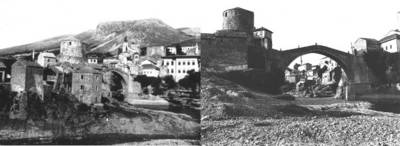
source [my stitching]

Some Bosnian stamps featuring the Old Bridge at Mostar (from 1906):
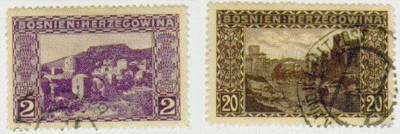
source [my stitching]

Another picture of the old bridge:
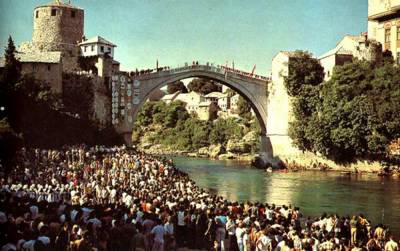
Annual diving contests were held at the Old Bridge.
source

History of Stari Most, found at www.domovina.net
Links:
Mostar's most famous landmark became a single-arch stone bridge over the Neretva River. It was designed in 1566 by the Turkish architect Mimar Hairedin, who studied under the greatest of all Ottoman architects, Sinan. The bridge was a masterpiece of Ottoman baroque architecture, and is one of the most beautiful bridges in the world. Known as the "Old Bridge" or "Stari Most", it is the city's namesake.
[snip]
For Bosnia's Muslims, raising the "Old Bridge" is an act as deeply symbolic as its destruction. However, putting Bosnia-Herzegovina back together will take more than rebuilding a bridge. In Mostar, Croats have shown little willingness to reunite the city, remaining stubbornly separate from Muslims.
Since the war, organized crime is on the rise. The anarchy of war can provide new opportunities for criminals to thrive and profit. In Mostar men who were in and out of prison before the war now drive through the city streets in modern cars and sedans. They have little use for peace agreements or the return of law.
Mostar had a population of 130,000 before the war. The devastating fighting left approximately 60,000 people, split between Muslim and Croat. From the devastation of shelling a few short years ago, the good life is starting to re-emerge in Mostar, shops are opening with displays of Levis and Italian shirts. An ABC Sweet Shop is open, located in the old town. The situation is improving slowly as some factories reopen and start to hire people. The city's previous economy was based on textile, tobacco, food-processing and bauxite mining and all these industries have survived.
On the west side of the Neretva River, cafes, boutiques and restaurants are in abundance as well as two discos full of young people. Remarkably, in some places in Mostar it is now possible to believe there never was a war. More and more people are beginning to cross the border of hate.
The western bank of the Neretva River is the modern, predominately Croatian side of the city. During the war, after uniting to fight off the Serbs, the Muslims and Croats turned their guns on each other. The western portion of the city Croat area, was not as severely damaged as the eastern bank of the Neretva River in which Muslims predominate.
- RealVideo links [source]:
- Reopening Stari Most - RealVideo report recorded from German ARD TV
- Reopening Stari Most - RealVideo report recorded from BBC TV <>Reopening Stari Most - RealVideo report recorded from Euronews TV
- Many pictures of the new Old Bridge
- Mostar webcam
- Re-opening ceremony program (Mostar city site)
- big website on Mostar by John Kozlich
In a city long an emblem for the bigotry and apartheid blighting Bosnia, Milan Milesovic this week struck a small blow for decency and common sense. On Sunday evening, the ambulance driver from the Croat west side of a city divided ethnically for 10 years switched on his flashing blue lights and raced across the bridges over the Neretva river to respond to the emergency call of a sick Muslim on the other side. "I am just doing my job. It's normal," Mr Milesovic shrugged.
But in a town where the takeaway pizza joint will not deliver to the Muslims across the river, where Croats and Muslims can be identified by their different mobile phone numbers and servers, where education from kindergarten to university is strictly segregated, and where you still cannot take a city bus across the old frontline from the Bosnian war, the ambulance driver's mission of mercy was anything but normal.
Here is a photo from Mr. Kozlich's website, showing how Mostar residents attempted to save the Old Bridge from Croatian shelling:
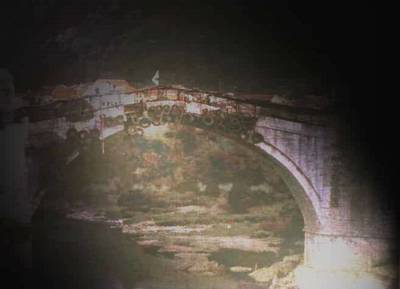
The Old Bridge festooned with old automobile tires. Source.

A historic city clings to the hope of survival. The "Old Bridge", festooned with old automobile tires in a gallant attempt to protect it from the ravages of shell and mortar fire, stood in testimony to the most fervent hope of the trapped citizens of the shattered town of "MOSTAR" - that somehow the gap between war and peace can be bridged and life allowed to resume again.Mr. Kozlich's site is a bit misleading about the re-construction of the Old Bridge--very few pieces of the original bridge were able to be used in the re-construction. For more on the engineering of the bridge restoration project, spend a few hours browsing the Stari Most website of General Engineering of Florence, Italy. It has wonderful detailed drawings and descriptions of all aspects of the project--and I mean all aspects. Here is part of an interview with a member of General Engineering's team:
Journalist - Will those portions be composed by the same ancient stones of the former structure ?
Mr.Romeo - No, no way… We have to understand that with war something has been definitely lost and it will not be possible to recover it. At the very beginning of this assignment everybody involved in this ambitious project was thinking and hoping to have the technical possibility to rebuild the bridge following a sort of anastilosis technique…
Journalist - what do you mean by "anastilosis technique" ?
Mr.Romeo - You perform an anastilosis reassembling when you remount single destroyed elements of a small portion of a monument in the original locations trough the help of wide and reliable documentation and by declaring the portions that underwent to these peculiar procedure in respect of the original ones. This way the integrity of the monument is preserved with its historical value, but those portions will have a lower relevance. Of course this is generally possible only if applied in small portions of the whole structure: it was not the case of the Old Bridge of course.
Journalist - Why wasn't it possible to proceed this way also for the Bridge ? was this only a matter of quantities and percentage of portion of the monument that was blown in to pieces ?
Mr.Romeo - Not exactly: it was the small quantity of recovered stones from the river: think that, counting also those stone blocks still on site next to the abutments wall, we could reposition in the original location not more than 22% of the global amount. But this was an optimistic evaluation since many of these stones were fractured in the inner portions and moreover most of the voussoir, (arch stones), were assembled in big blocks trough the ancient anchoring system. This would have required to disassemble those stones with a procedure that might have provoked further damages to the stones and the definite loss of the examples of the ancient refined assembling technique used at the time. In other words even in the case that technical issues could be faced, there were so little stone of the former bridge available, that we would have gained a new bridge with some stones of the old one inserted as spots. It was decided that this was not acceptable.
Journalist - This is really disappointing… but how is it possible that so many stones have been lost ?
Mr.Romeo - I have no precise idea… but as far as I'm concerned, I can say that trough careful examination of the video documentation of the destruction of the bridge it was clear that a large amount of the stones of the bridge were reduced to powder due to multiple direct hits of the shelling. Moreover I think that if you take a stone and let it fell down from an height of 20 meters together with other stones and over the rocks in the bottom of the river… then I presume that you might find many small fragments and a few preserved blocks…
Journalist - Therefore the bridge will be a new bridge ?
Mr.Romeo - Yes, we can call it "the new Old Bridge"
Journalist - How can this bridge have the same value and same symbolical meaning of the former one?
Mr.Romeo - It will not have the same value, nor the same symbolical meaning, and it couldn't be otherwise. The destruction of the bridge is now part of our history and it would be simply an utopia to cancel it. The new old bridge will be spanning over the Neretva and everybody will know that this is a copy of the former one: there will be different declarations devices in order to show the limit from which the new structure starts, and this will be also the way to remember tragic war events trough the observation of this bridge that will restore the global view of the monumental complex, the memory, the cultural identity and the symbol of the people. But for sure we can not, and we should not, consider it the same old bridge.
Father, let me dedicate All this year to you
In whatever earthly state You will have me be
Not from sorrow, pain, or care Freedom dare I claim;
This alone shall be my prayer: Glorify Your name.
--from New Year's Hymn by Lawrence Tuttiett, 1864 (alt.)
In whatever earthly state You will have me be
Not from sorrow, pain, or care Freedom dare I claim;
This alone shall be my prayer: Glorify Your name.
--from New Year's Hymn by Lawrence Tuttiett, 1864 (alt.)
